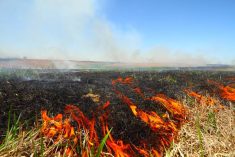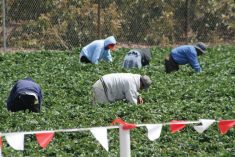Better farm safety can start with small steps.
Even a simple act like hanging a sign can play an important role in preventing a disaster.
“We have these lockout tags that say ‘Lockout. DO NOT OPERATE,’” said Donna Trottier, extension co-ordinator of the AgSafe Alberta program. “There was an incident a farmer told me about. The farmer was planning to mix some feed for his dairy cows. He went in the house for lunch, came out and started up the feed mixer. When he looked back there was a hand coming out of the mixer at the top.
Read Also

Farming Smarter receives financial boost from Alberta government for potato research
Farming Smarter near Lethbridge got a boost to its research equipment, thanks to the Alberta government’s increase in funding for research associations.
“As it turns out, one of the employees saw some twine at the bottom of the mixer so he got in to pull it out. When the mixer started he got all entangled in the equipment. He ended up spending several months in the hospital.
“Had the employee put one of those lockout tags on the steering wheel, the equipment would not have been started without checking why the tag was in place. The injuries could have been avoided. It’s really all about communication and having a process on the farm for communicating what each other is doing.
“I tell that story at trade shows; when I’m passing out those lockout tags people kind of dismiss them but then I tell them that story and they understand the practical applications and end up taking three or four of the tags for use on their farms.”
The 356 claims accepted by the Workers Compensation Board in the first six months of 2016 underscores the need for better communication between those who work on farms and ranches, she added. It’s one of the things AgSafe Alberta’s on-farm advisers emphasize when they help farmers develop their safety plans.
“We have QuickStart guides to walk farmers through the key components of a program,” said Trottier. “We’ve tried to tailor each QuickStart guide down to four easy steps. For example, the hazard management program suggests you select a job, such as spraying, identify the hazards of that job, what control measures do you or should you have in place and then train everybody about those hazards and controls you have in place for them.”
As much (or as little) help as you want
AgSafe Alberta’s on-farm adviser program is a free service for producers. The first step for those wishing to participate in the program is to either fill out a form at the AgSafe Alberta website or email inquiries to [email protected].
An adviser will then call to discuss logistics.
“They will discuss the type of operation they have, the level of safety programming they already have on their farm and the level of farm safety programming that they may be looking for assistance with,” said Trottier.
“Then the adviser will make arrangements to come out to the farm, sit down with the producer and talk about targeting the farm safety program to meet the needs of the producer. It may involve walking around the farm identifying areas of concern for the producer. If they want to take it to the next level, the advisers can help them train employees or family members on farm safety.”
Producers can participate in a few ways. They can let an adviser develop a farm safety plan or get recommendations and develop a plan themselves. They can also skip the adviser component entirely and use the other free resources available on the website.
“There are QuickStart guides on the website to help farm managers develop safety programs themselves. We’ve also developed quite a few videos, such as how to do a hazard assessment.
“And then we have two videos we call ‘Speaking from Experience’ that include interviews with people who were seriously injured in a farm incident. They talk about how the incident impacted their lives, what they changed to prevent that incident from happening again and advice to other producers to prevent a similar occurrence on their farm.”
Interest in the adviser program has been strong since it started a few months ago, said Trottier. “It seems to be the progressive farmers — the leaders in the industry — who are embracing the help being offered. There appears to be pockets of demand; word gets out in a certain area and neighbouring producers call in and request guidance.”
One of the biggest concerns is that the program will be “excessive,” said Trottier.
“We just want to assure them that we make the programs practical and customized to the type of farm. We only develop to the level of programming that producers are willing to implement and carry forward with.”
Taking a proactive approach
Hanneke Camps — who grows potatoes, sugar beets, sunflowers, wheat and grain corn with her husband Michel on their farm southwest of Barnwell — enrolled in the adviser program because she wanted a better way to train seasonal workers about farm safety. The adviser input gave Camps the idea of encouraging her full-time staff to become more proactive in helping seasonal employees work safely.
“(Previously) our full-time staff would see seasonal staff do unsafe things and would leave it up to management to correct them, but now we have a sense of ‘It’s our farm and our safety,’” said Camps.
“Anyone can speak up in regards to safety because if something does happen or almost happens it should be talked about so we can take charge and make sure nobody gets hurt.”

Camps, who serves on the AgSafe board, has also expanded her safety training sessions for new workers from a half-hour to two hours.
“If you take more time to train people, they’re more safety minded. If you give them a quick 10-minute run they’re going to feel like it’s just something that had to get done and it’s not a big priority.”
AgSafe Alberta is one of several initiatives by the AgCoalition in response to Bill 6 — the controversial farm safety legislation introduced in 2015. The project was initially funded by a Growing Forward 2 grant and has now been taken over by the AgSafe Society of Alberta. That organization evolved out of AgCoalition, a broad alliance of provincial farm groups that wanted to ensure workplace safety regulations were sensible and practical.
















